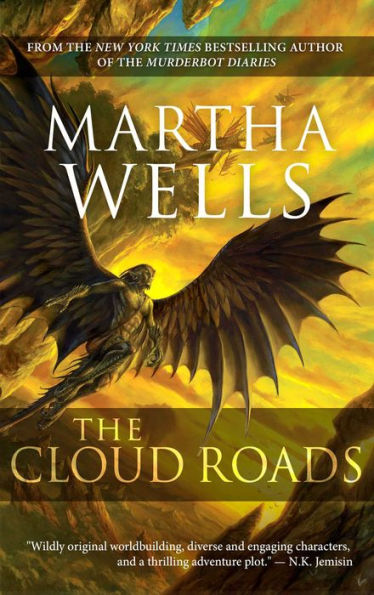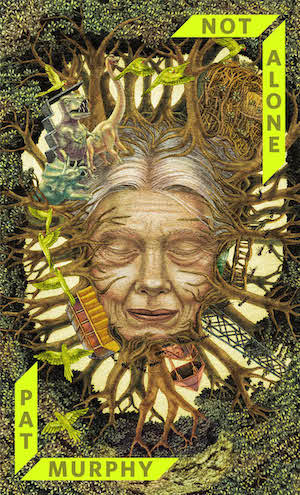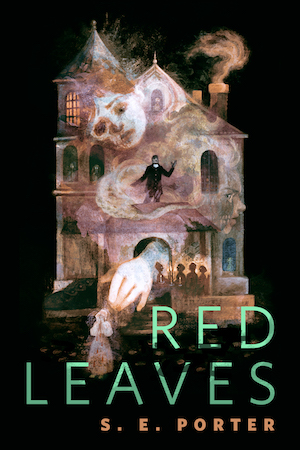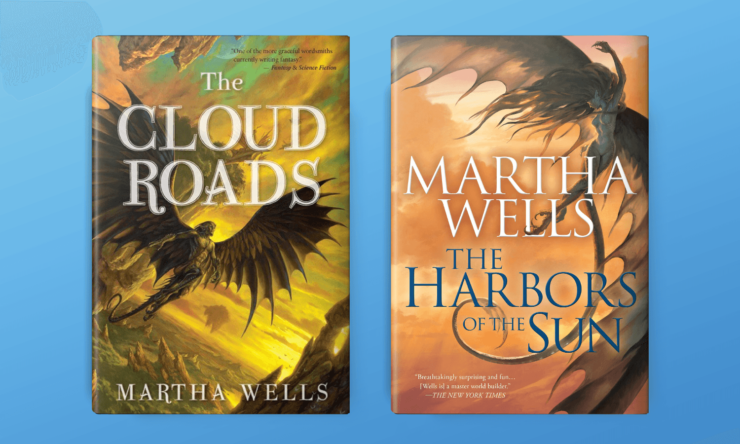Sometimes you think you’re talking about an invading army when you’re actually talking about a swarm of locusts. Not in the real world, mind you. Metaphorical rhetoric aside, we can (or should be able to) tell the difference between bipedal primates and six-legged arthropods. But in speculative fiction things get complicated. Sometimes the army looks like the swarm—a favorite trope of SF going way back in many classics of film and literature—but that’s fine, that’s cool, we can handle our Arachnids and Buggers and Xenomorphs just fine.
Where it gets a bit more complicated is when the swarm looks like people.
Even as an enthusiastic, self-appointed cheerleader for Martha Wells’ Books of the Raksura, I sometimes struggle to explain the series’ worldbuilding to potential readers. Not because the world doesn’t feel vivid and real to me, but because it’s hard to succinctly describe an imaginary world without resorting to real-world analogues like “fantasy War of the Roses” or “space opera Byzantine empire” or “magical Nordic saga” or yet another “inspired by Victorian London.” (I suspect there are more of those than there were ever actual Victorian Londoners in Victorian London.) These real-world analogues are so ingrained in how we talk about science fiction and fantasy literature that to be denied that shorthand causes a bit of mental flailing.
That doesn’t mean there aren’t real-world analogues in the Books of the Raksura. It just means that they aren’t always human analogues. I have to admit it took me—a person with multiple degrees in the natural sciences—far too long to figure it out. I can justify it by claiming that I was so swept up in the world and story that I wasn’t thinking about how to classify or corral, but that’s really no excuse for not realizing much sooner how all the vibrancy, weirdness, and rich diversity of the world in the Raksura books is comparable not to eras or nations of human history, but to the natural world.
Buy the Book


The Cloud Roads
The geomorphology of the fictional world is familiar to us, as there are mountains and rivers, cities and ports, swamps and deserts, storms and seasons. There is also magic, so among all that is familiar there are flying islands, trees the size of mountains, airship ports, floating cities, underwater prisons, ancient ruins, and so much more. And living among all of that, we find cultures in which there are insect hives as cities, symbiotic parasitism as systems of commerce, physical heteromorphism in place of castes and classes, and so many more different kinds of weird, wonderful life that there is no way I could describe them all here.
All of this makes the world of the Raksura a delight to travel through. That feeling of joy, that giddy desire to see and experience more of an imaginary, impossible, beautiful place, is part of why Wells’ worldbuilding is so successful. When a fantasy world is so strange and beautiful and interesting, full of details and quirks and layers, it can be so beguiling we feel ourselves drawn in—not just to the characters and their trials, not just to the plot with all its twists and turns, but into the fabric of the world itself. There is a lot of discussion in SFF circles about how much worldbuilding is too much, how much needs to be on the page and what could be left off, how an introduction can become an info-dump, etc. I’m not convinced we need elaborate rules or advice when for me, as a reader, all it comes down to is this: if I can feel like I’m there, it works.
But wanting to transport oneself to a fantasy world for a beguiling (and dangerous!) holiday is one thing, while filling that world with powerful stories is something else entirely. I wrote quite a lot about what I think of the emotional depth of the Books of the Raksura in my previous essay, but I specifically set the worldbuilding aside to deal with separately—partly because there is quite a lot of it, but also because it requires stepping back and taking a broader view of the series (without getting into any major spoilers, for those who haven’t read the books).
Much as the non-human nature of the main characters allows the Raksura series to explore interpersonal relationships without all the messy trappings of human hang-ups, the non-human nature of the world’s species allows the narrative to explore certain elements of societies and cultures without relying on assumptions drawn from real-world human history.
One of these elements is the series’ treatment of what it means to be a person. The other is its treatment of what it means to be a civilization.
So let’s get into the talking flowers.
There is a scene in Harbors of the Sun, the final novel in the series, in which Moon and Stone have a brief encounter with a very annoying plant. They are traveling through unfamiliar territory, and trying to figure out what they can hunt and what might be wanting to hunt them. This strange creature, which is described as having “a head shaped like a rounded, multi-headed flower, a little like an aster,” turns out to be neither predator nor prey, only an annoyance, because, Moon reasons, “You couldn’t eat something that talked, no matter how stupid it was, and there was no point in killing it otherwise.”
By this point in the series, for anybody who has been reading along since The Cloud Roads, these sorts of events are only to be expected. One name the characters have for their world is the Three Worlds—this refers not to three continents or three kingdoms or three nations, as we might expect, but to the three worlds of land, sea, and sky. All of these realms are inhabited by dozens of sentient species adapted to each environment, and many species that can move between the environments. And, yes, that includes talking plants, and so much more.
I’m going to emphasize that because it’s so important to the worldbuilding: There are literally dozens of fully sentient, intelligent species who live in every imaginable environment. There are flying species who live among the clouds, aquatic species who live in the seas, and arboreal species who live in forests. There are two-legged ground-dwelling species who build cities such as we understand them, but those are definitely not the only city-builders around; there are also hives, warrens, floating islands, and settlements suspended from trees. Every single one of the species has cultures and communities of its own, and many of them interact regularly. They speak with each other, trade with each other, fight each other. They learn each other’s languages, learn and challenge each other’s customs, share each other’s food. Sometimes they eat each other, because intelligent predators can have cultures and communities too, and not everybody shares Moon’s opinion that food that talks is off-limits. We meet everyone from small forest-dwelling foragers and farmers to telepathic, cannibalistic invaders who overtake entire cities simply to deplete all the resources before moving on.
None of them are human. All of them are people.
Whether they have blue skin or scales or hive minds or carrion diets or extreme heteromorphism or shapeshifting forms, they are people.
That is something that we, as readers, are not given a chance to question, because we begin the series firmly in the perspective of a character for whom this is all natural and normal. We don’t have any choice but to accept Moon’s opinions on what counts as a person and what doesn’t, and he’s not the most creative thinker in that respect, being far more concerned with survival than philosophy. If he can communicate with them, they are a person. Even if they want to eat him, or look like a giant spider, or happen to be a flower, they are a person. That’s it. That’s the rule Moon lives by.
We very quickly learn, however, that not everybody’s worldview is quite so straightforward. Moon and the other Raksura are constantly meeting people who view them—in all their clawed, winged, scaly, shapeshifting glory—as everything from animal specimens to savage barbarians to mystical shamans. Because of their physical similarity to another species (more on that in a moment), they are often believed to be nothing more than ravenous invaders who want to eat everybody in town. Just like in our messy human world, the rules about who counts as a person and who doesn’t vary between places and cultures and individuals.
And just like in our messy human world, thinking too hard about making those distinctions—which Moon never does, the darling, but which we get to do as readers—immediately reveals just how utterly absurd such an exercise can be. This may not be a human world, and the characters are not imbued with human prejudices, but the frustration the characters feel at being repeatedly classified and reclassified by others is going to be familiar to many readers who have had to argue their humanity to people who will use any reason they can to deny it.
There is something bracingly clarifying about how this is all laid out in the Raksura books, from the Raksuran perspective. When you meet someone, you have a choice. Either you view them as a resource to be used for your own gain, or you don’t. You capture them to put them in museum, or you don’t. You invade their cities and destroy their societies and kill their entire populations, or you don’t. You treat them like people, or you don’t.
To be clear, we are, in fact, still talking about fictional people in a world full of magical scaly shapeshifting flying angst-magnets with a lot of personal trauma to cope with.
Except, of course, that we’re never really only talking about fiction when we talk about fiction, are we? We can’t extract any literature from the world in which it is created. Pretty much the entire history of humankind is one of making the wrong choice for every one of those options, over and over again, in all kinds of creatively horrific ways. It happens every day, everywhere. It is happening right this very moment as people all the world over decide whose lives are worth less than their own fortunes, their own prejudices, their own sense of superiority.
That’s where we get into the second aspect of the worldbuilding in the Books of the Raksura that I find so fascinating, and that is the concept of civilization as it exists in that world.
I am not an anthropologist or historian, and I confess that the word “civilization” still mostly makes me think of the computer game (the original early-‘90s version, at which I was such a bad player I considered it a success if I managed to develop a chariot and a granary) rather than a rigorous concept of human social and cultural development. But within my layperson’s perspective, all the trappings of what we think of as civilization are present in the Three Worlds: large population centers, shared languages, massive construction projects, division of labor, and so on. The books spend time exploring various cities, both living and long-dead, that show a long history of complex and changing cultures. There are massive, ancient ruins everywhere, indicating that different species of people have been organizing and cooperating throughout that history. There are languages and writing systems, technology (much of it driven by magic) and commerce, agriculture and artistry, education and science and research.
(Aside: There doesn’t seem to be much in the way of religion, at least not that I recall, but I didn’t notice the lack until I started thinking about it. That seems like it ought to be a lesson for fantasy worldbuilders about how bold you can be in ignoring aspects of human cultural systems while building rich imaginary worlds.)
So there are many elements of the world that fit our concept of what civilization is. But the Raksura—both as individual characters and as a culture—don’t seem to share that concept at all.
They do not see small, agrarian settlements or nomadic groups as “primitive” or “developing,” nor do they see large cities with complex cultures as “advanced” or “civilized” or something to aspire to. They don’t look upon the massive architectural ruins of dead societies as evidence of past greatness or superiority. They don’t view their nearest neighbors, the forest-foraging villagers called the Kek, as less advanced or less accomplished simply because they live in wooden huts, use wooden tools, and speak a language entirely unlike their own. Nor do they view the many species of people who live in large cities full of bustle and commerce and social stratification as more advanced or more accomplished.
There is an interesting moment in one of the books where somebody has to explain to a Raksuran character the concept of servants and a service class, because the Raksura have no such strata and have no context for a culture in which such classes exist. To them, having servants and masters in a system of resource disparity is not a natural result of cultural development but a weird, unsettling custom that some people insist upon observing even though it makes no sense.
That is not to say those concepts don’t exist in the Three Worlds. There are several groups of people who hold the hierarchical view that civilization is a series of steps that a culture must progress through in order to climb toward some lofty goal. These people view the tree-dwelling, raw-game-eating, constantly in-fighting Raksura as “primitive” and “savage.” But it is not the dominant view in the world, and it is certainly not the dominant view in the narrative. The Raksuran characters tend to greet such judgments with exasperated eye-rolling about how weird and rigid and full of bizarre quirks other people and cultures can be.
Then there are the Fell, a primary enemy of the Raksura and main antagonists of the series. They are also winged predators and bear a physical resemblance to the Raksura, but their behavior couldn’t be more different. While the Raksura have cherished homes, elaborate customs, and an intensely communal culture built around arguing quite a lot about how to care for everybody, the Fell don’t seem to have any culture of their own at all. Their entire existence revolves around infiltrating population centers, telepathically manipulating the inhabitants to let them in, play-acting at fitting in for just long enough to attack and kill everybody for food. They have nothing beyond what they steal from others, use until it bores them, and ultimately discard.
The Fell are more a swarm of telepathic locusts than a marauding army, but they are still people by Three Worlds standards. They are not considered to be “animals” or even “barbarians,” acting as they do only because they haven’t properly ascended the ladder of so-called civilization, because that’s another concept that has no meaning in their world.
Buy the Book


Salvation Day
I keep using the scare-quotes up there because just writing this all out makes me realize how hard it is to talk about civilizations that don’t fit within human history. We can talk about how empires rise and fall, how kingdoms clash and dynasties end, how cultures advance from stone to bronze to iron. Right now, in the midst of this current global crisis, the news is full of articles about failing systems and states, about apocalypses and revolutions, about humanity and the challenges we face, the problems we cause, the pain we suffer. As humans we talk about humankind and its civilizations all the time, in hundreds of different ways.
One of those ways is, of course, through fantasy and science fiction literature, whose authors put a great deal of thought into developing and dissecting their own ways of seeing the world. The Books of the Raksura are no different, and what I really love about them, both as a reader and as a writer, is how they do this not by holding up a mirror to that era or this culture or yet another grimy street in Victorian London, but by stripping away so many of the rules and assumptions that govern human societies and letting the wild, wondrous diversity of the natural world be the guide instead.
Far from being remote or hard to parse, this results in a world that is comforting in the same way the emotional arc is comforting, one in which reading feels like letting yourself wander through a place that may be weird, it may be dangerous, it may be full of people who want to eat you, but it is still welcoming in its wonder and strangeness and refreshing lack of adherence to the social and cultural dogmas that shape our thoughts every day. It’s refreshing to spend some time in a world where giant crabs can be people, where insect hives can be cities, where every encounter and exploration introduces people and places and cultures with such vast diversity that it makes all of our petty little human differences seem as silly to us as the idea of servants or money or sexual taboos seem to the Raksura.
Even more than that, what these books demonstrate to me is that, yes, of course, it is possible to imagine a world that isn’t bound by our rigid and ingrained ideas about what societies must look like and how civilizations must evolve. That isn’t a lesson that only fantasy writers need to learn. It’s one that we all need to keep learning, over and over again, as much as we can, for as long as we can. Now is as good a time as any to start.
Kali Wallace studied geology and earned a PhD in geophysics before she realized she enjoyed inventing imaginary worlds more than she liked researching the real one. She is the author of science fiction, fantasy, and horror novels for children, teens, and adults. Her most recent novel is the science fiction thriller Salvation Day. Her short fiction has appeared in Clarkesworld, F&SF, Asimov’s, Tor.com, and other speculative fiction magazines. After spending most of her life in Colorado, she now lives in southern California.











Great article! I adore Martha Wells’ Raksura books and you have written succinctly and beautifully about elements which make these books so appealing. Gather up all your Wells analyses and put them into a book!
This analysis leaves me eager to read Martha Wells’ Books of the Raksura! I’m curious: is Wells a vegan? Oh and Kali Wallace, may I ask also whether you are vegan? If not, does reading Wells motivate you to explore vegan views on compassion, and on animal rights?
@2 – I had the same idea/question after reading this post. One of my friends is a vegetarian who’ll still eat some sea food but not all of it. When I asked him how he decides what’s acceptable he answered “I won’t eat it if it has a face,” which seems remarkably similar to the idea expressed in this post.
I really need to get to the Raksura books soon.
There doesn’t seem to be much in the way of religion, at least not that I recall, but I didn’t notice the lack until I started thinking about it. That seems like it ought to be a lesson for fantasy worldbuilders about how bold you can be in ignoring aspects of human cultural systems while building rich imaginary worlds.
Yeah, that’s an interesting point. For some reason, I’m reminded of C.J. Cherryh, whose fantasies (and SF stories) can feature very plausible, complex social settings with little or no religion (beyond a tendency for characters to says things like “Gods!” when they swear).
Of course, the locus classicus of fantasy worldbuilding — Tolkien’s Middle Earth — features almost nothing in the way of in-world religion. (Leaving aside The Silmarillion, of course.) People like to point out that the Shire is in many ways a kind of idealized 19th Century English countryside — but where are the hobbit vicars?
(Martha Wells’ Wheel of the Infinite, on the other hand, is all about religion.)
@2
is Wells a vegan?
Leaving aside the question of whether you’re confusing veganism and vegetarianism — as if only vegans might care about “compassion and animal rights” — it’s maybe a little odd to imagine that, given that the Raksura are largely carnivores, with plenty of scenes where Moon and other Raksura casually kill and eat (non-speaking) animals.
(From following her blog the past year or two, with its occasional mention of trips to restaurants or holiday meals, I gather she’s an omnivore.)
@5 Going off the book topic here but vegetarians who care about compassion and animal rights need to educate themselves about what goes on in the dairy and egg-laying industries.
@5 — Thanks for the insight derived from the blog!
@3 — So many people have these kinds of criteria: “Does it talk?” or “Does it have a face?” or “Does it speak a language I know?” or “Does it have anything I recognize as being like a central nervous system, or even a single nerve cell?” Or just, “Is it something (or someone) I’ve been culturally indoctrinated into feeding on, like say a pig?” As compared with something I haven’t which is otherwise almost identical, like a dog. I hope Wells will at some point directly address these questions. I suspect Wallace (the author of this essay) might hope that too! ;-)
” somebody has to explain to a Raksuran character the concept of servants and a service class, because the Raksura have no such strata and have no context for a culture in which such classes exist.”
I guess I have to reread the series. I felt like there was a clear division of classes and importance. Queens were the ruling class, Consorts nearly of the same level although elderly consorts approached the queens in importance and the warriors, although they could fly, were sterile and so unimportant – my position from reading the books not my general view of people without children in general.
Maybe I read my dislike of human classes into this non-human class system and in a reread I will see your position. Since I love the series, I am happy more than anything else to go back to the series.
On veganism, not to totally derail this thread, but I suggest reading The Hidden Life of Trees: What They Feel, How They Communicate by Peter Wohlleben.
That said, Wells has done a great job in showing how a people can be carnivorous, apex predators and still respect their food sources.
@9 — Wells may do a fine job portraying carnivores who “respect” their prey. It would be quite a challenge to make the case they have compassion for those upon whom they feed, particularly when less sentient forms of food are also available to them.